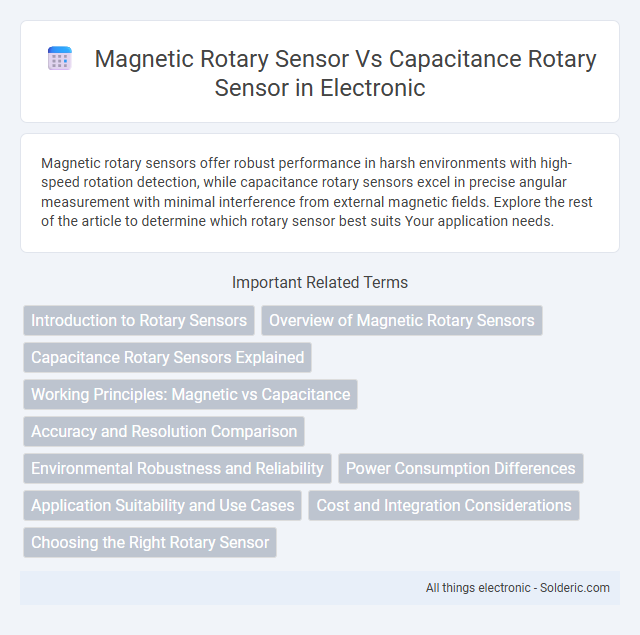Magnetic rotary sensors offer robust performance in harsh environments with high-speed rotation detection, while capacitance rotary sensors excel in precise angular measurement with minimal interference from external magnetic fields. Explore the rest of the article to determine which rotary sensor best suits Your application needs.
Comparison Table
| Feature | Magnetic Rotary Sensor | Capacitance Rotary Sensor |
|---|---|---|
| Operating Principle | Measures rotation via magnetic field changes | Detects rotation through capacitance variations |
| Accuracy | High accuracy with stable magnetic signals | Very high accuracy, sensitive to small changes |
| Durability | Robust, resistant to dust and vibration | Less durable, sensitive to environmental contamination |
| Environmental Resistance | Works well in harsh conditions (dust, oil, moisture) | Susceptible to moisture and dirt interference |
| Range of Measurement | Typically 0-360 degrees | Full rotation typically supported |
| Power Consumption | Low to moderate power use | Generally low power consumption |
| Cost | Moderate, widely available | Higher cost due to sensitivity and complexity |
| Applications | Automotive, industrial automation, robotics | Precision instruments, robotics, medical devices |
Introduction to Rotary Sensors
Rotary sensors detect the angular position or motion of a rotating object, playing a critical role in robotics, automotive systems, and industrial machinery. Magnetic rotary sensors use Hall effect or magnetoresistive technology to measure changes in magnetic fields, offering robust performance in harsh environments and immunity to dust and dirt. Capacitance rotary sensors rely on changes in capacitance between conductive plates, providing high accuracy and sensitivity but typically requiring cleaner conditions for optimal function.
Overview of Magnetic Rotary Sensors
Magnetic rotary sensors detect angular position using magnetic fields generated by rotating magnets, offering high durability and immunity to dust, dirt, and moisture. These sensors utilize Hall effect or magnetoresistive elements to produce precise, contactless measurements suitable for harsh industrial environments. Their robust design enables long operational life and reliable performance in applications such as automotive steering systems and industrial automation.
Capacitance Rotary Sensors Explained
Capacitance rotary sensors measure angular displacement by detecting changes in capacitance between conductive plates, offering high precision and immunity to magnetic interference. Unlike magnetic rotary sensors that rely on magnetic fields, capacitance sensors excel in environments with electromagnetic noise, ensuring consistent and accurate performance. Your choice depends on the application's sensitivity requirements and environmental conditions, with capacitance sensors providing enhanced stability in complex or electrically noisy settings.
Working Principles: Magnetic vs Capacitance
Magnetic rotary sensors operate by detecting changes in a magnetic field caused by a rotating magnet attached to a shaft, allowing precise angle measurement through Hall effect or magnetoresistive technology. In contrast, capacitance rotary sensors measure rotation by detecting variations in capacitance between stationary and rotating electrodes as the angle changes, relying on changes in electric field distribution. Your choice between these technologies depends on factors like accuracy, environmental conditions, and susceptibility to interference.
Accuracy and Resolution Comparison
Magnetic rotary sensors typically offer moderate accuracy with resolutions ranging from 12 to 14 bits, leveraging Hall effect or magnetoresistive technologies to detect angular positions. Capacitance rotary sensors provide higher accuracy and resolution, often exceeding 16 bits, due to their sensitivity to minute changes in capacitance caused by angular displacement. While magnetic sensors perform reliably in harsh environments, capacitance sensors excel in precision applications requiring fine angular measurements and minimal signal noise.
Environmental Robustness and Reliability
Magnetic rotary sensors exhibit exceptional environmental robustness due to their resistance to dust, dirt, moisture, and temperature variations, making them ideal for harsh industrial environments. Capacitance rotary sensors, while precise, are more susceptible to moisture and contamination, which can affect their reliability over time. Your choice should consider the operating conditions to ensure long-term sensor performance and durability.
Power Consumption Differences
Magnetic rotary sensors typically consume less power compared to capacitance rotary sensors because they rely on magnetic field variations detected by low-energy Hall effect or magnetoresistive components. Capacitance rotary sensors often require continuous excitation voltage to measure changes in capacitance, leading to higher power consumption in your application. Choosing a magnetic rotary sensor can optimize energy efficiency, especially in battery-operated or low-power devices.
Application Suitability and Use Cases
Magnetic rotary sensors excel in harsh environments with dust, moisture, and vibration due to their robust and non-contact sensing technology, making them ideal for industrial automation, automotive steering systems, and robotics. Capacitance rotary sensors offer high precision and sensitivity in clean environments, commonly used in medical devices, consumer electronics, and precision instrumentation. Your choice depends on the operating conditions and accuracy requirements, with magnetic sensors favored for durability and capacitance sensors for fine resolution.
Cost and Integration Considerations
Magnetic rotary sensors generally offer a cost-effective solution due to simpler manufacturing processes and fewer material requirements compared to capacitance rotary sensors, which tend to involve more complex fabrication and shielding techniques. Integration of magnetic sensors is often more straightforward, benefiting from non-contact operation and tolerance to contaminants, whereas capacitance sensors require precise alignment and controlled environmental conditions to maintain accuracy. The choice between these sensors should weigh initial costs against integration complexity and operational environment, with magnetic sensors favored in robust, cost-sensitive applications.
Choosing the Right Rotary Sensor
Magnetic rotary sensors offer high durability and resistance to harsh environments, making them ideal for applications requiring long-term reliability and immunity to dust or moisture. Capacitance rotary sensors provide superior precision and sensitivity, suited for environments where accurate angle measurement is critical but exposure to contaminants is minimal. Selecting the appropriate rotary sensor depends on balancing environmental conditions, required measurement accuracy, and application-specific demands for sensor longevity and responsiveness.
Magnetic rotary sensor vs capacitance rotary sensor Infographic

 solderic.com
solderic.com